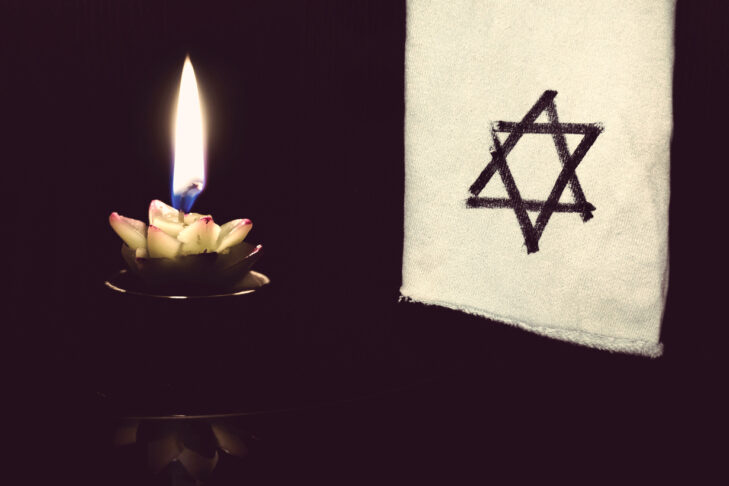The week of Parshat Ki Tisa last year was the week that everything changed. As the week began, we were still celebrating Purim, with a carnival, a dinner and a packed Megillah reading, taking the precautions to wash our hands and to greet each other with elbow bumps. The week was filled with what we didn’t realize would be our last pre-COVID days at school and work, our last communal meals and concerts, our last visits and hugs. Shabbat of Ki Tisa brought us our last pre-COVID bat mitzvah, celebrated with 50 people instead of 300, and a last-minute scramble to figure out how in the world we could livestream our services.
It’s been a long year since then.
But today’s Torah portion has been on my mind as parts of it have popped up as readings for special occasions lately. I was inspired to examine the three other times we read from Ki Tisa in this season, to look for lessons that could help us through this moment in time, the one-year anniversary of living in a world with COVID, the yahrtzeit of the coronavirus, if you will. I’ll invite you to join me on this exploration, which for me, had a surprising outcome.
The first time we read from Ki Tisa recently was when we read the opening verses of this parsha three weeks ago, on Shabbat Shekalim, on the new month of Adar. These verses describe a census taken by collecting a half shekel from each household to build and support the mishkan, the portable Tabernacle in the wilderness. While the specific act of supporting the mishkan, or in later centuries, the Temple in Jerusalem, has long since ceased, the tradition of reading this portion and emphasizing the importance of tzedakah at this time of year has continued.
>Last week, Leora Mallach taught a class for Temple Israel about the mitzvah of tzedakah on Purim. She shared Maimonides’ teaching that one should give more tzedakah on Purim than one spends combined on one’s own festive Purim meal and on mishloach manot given to friends.
I had this in mind when I saw friends posting on social media about their ambivalence about celebrating Purim while marking a year of our lives in a pandemic. Some friends wanted to give themselves and others permission to feel sad even amongst the Purim festivities, and others wanted permission to rejoice despite the sadness in the world around us.
It occurred to me that one positive way to react to the mixture of joy and sorrow of Pandemic Purim was through tzedakah. Whether inspired by the half-shekel offering, the holiday of Purim or the anniversary of COVID in our lives, tzedakah can address the serious needs around us, gladden or comfort the recipients and the givers and help us feel less alone and more interconnected.
The second time we read verses from Ki Tisa recently was last Thursday, the day before Purim. I’ve had a sporadic relationship with the four minor fasts in the Jewish calendar over the years—perhaps I’ve taken to heart the joke about the fast of Gedalia after Rosh Hashanah, in which the punchline is, “Gedalia wouldn’t have fasted for me, so why should I fast for him?” But our family has taken these fasts more seriously since we celebrated Zalmen’s bar mitzvah last summer on one of them. And a year into a pandemic seemed an appropriate time to observe Ta’anit Esther, the fast of Esther that leads into Purim.
The fast recalls Esther asking the Jews of Shushan to fast for three days in solidarity with her before she risked her life by approaching the king. It invokes the mortal danger posed to the Jewish people before she managed to flip the Purim script. And it acknowledges that redemptions are incomplete and imperfect, with the day of the fast, the 13th of Adar, the day originally slated for the destruction of the Jews, becoming at the end of the megillah a day of violence by the Jews.
The fast-day Torah reading jumps from Moses pleading for God’s mercy for the Jewish people (after the Golden Calf) to God teaching Moses the 13 divine attributes of mercy which we recite on festivals and the High Holidays.
This brings me to the second tool we can use around the coronavirus anniversary: teshuva (repentance). In this portion, God’s self does teshuva, turning back from anger toward compassion, and God and Moses establish a liturgy and mechanism for people to do teshuva and request Divine forgiveness.
It seems like this whole year, and the milestone we are marking, has been an opportunity for introspection. We’ve had a chance to learn more about ourselves, our families and our communities. We’ve had a chance to assess and reassess our priorities. And we’ve had a chance to think about which aspects of the “before life” we can’t wait to get back to, as individuals and as a community, and what changes we’d like to implement based on what we’ve learned when we emerge from the pandemic.
The third and final time that we read from Ki Tisa this season is in the middle of Passover, and this passage talks about the Jewish calendar, about Shabbat and the festivals, and includes the amazing passage about Moses longing to get close to God, and settling for experiencing God’s back, if not God’s face. This brings us to the third way of marking this anniversary—tefilah, prayer, trying to get close to the Divine. This could include meditation, yoga, exercise, personal prayers, a bedtime routine or joining with the community to daven on a weekday or Shabbat.
During the pandemic, I’ve found being with you on Zoom, seeing your faces and sometimes hearing your voices to be among the most moving and most important parts of my day and my week, whether at daily minyan or Shababa with the kids, coming together as we are right now to celebrate Shabbat or at Havdalah to delineate its end. This marking of time through the Jewish calendar has become, more than ever, an indispensable way for me to sense the passage of time in my own life and to feel it intersecting with yours.
The Maor VaShemesh, Rabbi Kalonymous Kalman HaLevi Epstein, who wrote and taught around the turn of the 19th century in Poland, comments on the Torah’s injunction in this portion to work for six days as well as resting on Shabbat. What about those who are retired, or unemployed, or who work for fewer than six days a week? He says that everyone works during the week, not only at their occupation, but through the work one does to improve the world, and in the ways we prepare physically and spiritually for Shabbat. Then Shabbat can sustain us throughout the rest of the week, when it may be harder to sense God’s presence.
Connecting to the Divine and community through prayer and through the Jewish calendar, albeit in unusual ways this year, have provided another route toward bringing meaning to our lives during the pandemic.
I didn’t have this in mind when I started, but you may have noticed that the three ways that our Torah portion suggested to guide us through these unusual times are also the themes at the crux of the High Holiday amida: Uteshuva, utefila, utzedakah, maavarin et roa hagzeira—repentance, prayer and tzedakah can completely change our lives and our relationship with the world around us. You might be thinking, “Why are we possibly talking about teshuva, tefila and tzedaka when the High Holidays couldn’t be further away?” I have three reasons I think this “untimely message” couldn’t be more timely.
First, there’s a strong rabbinic connection between Yom Kippur and Purim, Yom Kippurim being in the kabbalistic teachings Yom K’Purim, a day like Purim. The holidays are yin and yang, complementary opposites with much in common: both holidays involve lots, going before the king and, as Rabbi Joseph Soloveitchik wrote, “a call for Divine compassion and intercession, a mood of petition arising out of great distress.”
Second, the Elul and High Holiday season is the time when, according to the midrash, the last section of Ki Tisa takes place. After the Golden Calf and the Divine plague that follows, Moses ascends Mount Sinai again on Rosh Chodesh Elul, carves a new set of tablets and descends with them 40 days later, on Yom Kippur. In some ways, this full year of COVID feels like a long High Holiday season, or a prolonged preparatory month of Elul.
And third, and most importantly, these guiding principles aren’t meant to be recited on Yom Kippur and forgotten until next Elul. I wonder whether the rabbis purposely planned these extra readings from Ki Tisa to remind us of these principles when we’re furthest from the High Holidays and most likely to forget them. Each of these things—teshuva, tefila and tzedakah—are hard. They’re challenges for every day of our lives, ones that I routinely feel I am falling short of, but for which we have the opportunity to strive anew each day. And they seem especially needed in this moment, when we may feel frustrated, lonely and looking for the willpower, the patience and fortitude to preserve our good pandemic practices and protect each other for just a little longer.
As we mark the yahrzeit of this debilitating disease in our community, and as we acknowledge this topsy-turvy year, in which it is hard to be sure when to laugh and when to cry, when it’s Purim and when it’s Yom Kippur, may the tools of teshuva, tefila and tzedakah—introspection, Divine connection and generosity—help lead us through the last stages of the pandemic and to the new reality that we yearn for, that we can almost taste, that awaits us on the other side.
This post has been contributed by a third party. The opinions, facts and any media content are presented solely by the author, and JewishBoston assumes no responsibility for them. Want to add your voice to the conversation? Publish your own post here. MORE



